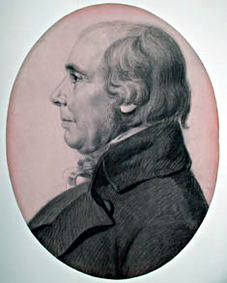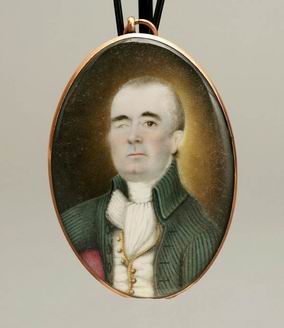Related Research Articles
Colonel Stevens Thomson Mason was an American lawyer, military officer and planter who served in the Continental Army during the Revolutionary War. Mason was also a delegate in the Virginia General Assembly and a Republican U.S. Senator from 1794 to 1803.

William Fitzhugh was an American planter, legislator and patriot during the American Revolutionary War who served as a delegate to the Continental Congress for Virginia in 1779, as well as many terms in the House of Burgesses and both houses of the Virginia General Assembly following the Commonwealth's formation. His Stafford County home, Chatham Manor, is on the National Register for Historic Places and serves as the National Park Service Headquarters for the Fredericksburg and Spotsylvania National Military Park.

Charles Fenton Mercer was a nineteenth-century politician and lawyer from Loudoun County, Virginia who served in the U.S. House of Representatives and the Virginia General Assembly.

Leven Powell was a Virginia planter, merchant, Continental Army officer and Federalist politician who served several terms in the Virginia House of Delegates as well as in the Virginia Ratification Convention representing Loudoun County, and one term as a United States representative for Virginia's 17th congressional district.
Cuthbert Powell was a Virginia lawyer and Whig politician who served in both houses of the Virginia General Assembly and one term in the U.S. representative from Virginia, like his father, former Congressman Leven Powell.

The Northern Neck Proprietary – also called the Northern Neck land grant, Fairfax Proprietary, or Fairfax Grant – was a land grant first contrived by the exiled English King Charles II in 1649 and encompassing all the lands bounded by the Potomac and Rappahannock Rivers in colonial Virginia. This constituted up to 5,000,000 acres (20,000 km2) of Virginia's Northern Neck and a vast area northwest of it.

William Henry Fitzhugh was Virginia planter and politician who served in both houses of the Virginia General Assembly, as well as in the Virginia constitutional convention of 1829–1830 and as an officer of the American Colonization Society.

Nolands Ferry I Archeological Site is an archaeological site near the historic Noland's Ferry boat landing at mile 44.58 on the C&O Canal and Tuscarora. The Archeological Site is a prehistoric occupation site located in the Monocacy region of southern Frederick County, Maryland. Diagnostic artifacts at the site indicate that the site was almost continuously inhabited from the Paleo-Indian period to the early 19th century, with the most substantial inhabitation occurring during the Late Woodland period.
Thomson Mason was an American lawyer, planter and jurist. A younger brother of George Mason IV, United States patriot, statesman, and delegate from Virginia to the U.S. Constitutional Convention, Thomson Mason would father Stevens Thomson Mason, and was the great-grandfather of Stevens T. Mason, first Governor of Michigan.
Nicholas Battaile Fitzhugh was a Virginia lawyer and politician who became a United States circuit judge of the United States Circuit Court of the District of Columbia after representing Fairfax County in the Virginia House of Delegates.
George Mason III was an American planter, military officer, legislator and government official. Although he repeatedly won election to represent Stafford County in the then-one-house Virginia General Assembly, he may today be best known as the father of George Mason IV, a Founding Father of the United States.
Charles Simms (1755–1819) was a Virginia lawyer, Revolutionary War officer and politician. A friend of George Washington, Simms thrice represented Fairfax County, Virginia, in the Virginia House of Delegates as well as at the Virginia Ratification Convention of 1788, and also served as mayor of Alexandria during the War of 1812.
David Stuart was a Virginia physician, politician, and correspondent of George Washington. When Washington became President of the United States, he made Stuart one of three commissioners appointed to design a new United States capital city.
Matildaville is a ghost town located along the Patowmack Canal near present day Great Falls, Virginia, United States. It was named for the wife of Light Horse Harry Lee, on 40 acres of land owned at the time by Bryan Fairfax, 8th Lord Fairfax of Cameron, and served as headquarters for the Patowmack Company from 1785 until 1799. Now, all that remains of the town are a series of ruins on the grounds of Great Falls Park.
Isaac Parsons was an American slave owner, politician, and militia officer in the U.S. state of Virginia. Parsons served as a member of the Virginia House of Delegates representing Hampshire County from 1789 until his death in 1796. Following an act of the Virginia General Assembly in 1789, Parsons was appointed to serve as a trustee for the town of Romney. In 1790, Parsons began serving as a justice for Hampshire County. He served as a captain in command of a company in the Virginia militia during the American Revolutionary War and continued to serve as a captain in the Hampshire County militia following the war. Parsons operated a public ferry across the South Branch Potomac River, and later died from drowning in the river in 1796. Parsons was the grandfather of Isaac Parsons (1814–1862), who also represented Hampshire County in the Virginia House of Delegates and served as an officer in the Confederate States Army.
Rice Hooe was the name of three Virginia colonists, two of whom served in the colonial House of Burgesses, and became ancestors of a family of planters important in northern Virginia and southern Maryland. Their descendants Alexander Hooe, Bernard Hooe Jr., James Hooe, two named John Hooe as well as John Hooe Jr., and William Hooe would all serve in the Virginia General Assembly before the American Civil War.
Ludwell Lee was a prominent American lawyer and planter who served in both houses of the Virginia General Assembly representing Prince William and Fairfax Counties and rose to become the Speaker of the Virginia Senate. Beginning in 1799, following the death of his first wife, Lee built Belmont Manor, a planation house in Loudoun County, Virginia, which today is on the National Register of Historic Places.
Francis H. Peyton was a Virginia planter and patriot in the American Revolutionary War, and who represented Loudoun County, Virginia in the House of Burgesses, Virginia Conventions and both houses of the Virginia General Assembly.
John Pope was a Virginia planter and politician who represented Prince William County, Virginia in both Houses of the Virginia General Assembly, first in the Senate, and then in the House of Delegates.
Martin Scarlett or Scarlet, was a Virginia planter and military officer who served in the House of Burgesses representing Stafford County, as well as in local offices, including Justice of the Peace in 1680. Scarlett had emigrated from England and stated in a 1691 court that he had lived in Stafford County for more than 30 years, which record survived because the case had been appealed to the General Court in Williamsburg.
References
- ↑ "House History". history.house.virginia.gov. Retrieved 2023-09-29.
- 1 2 "The Carolina Road – Today's Route 15 | History of Loudoun County, Virginia" . Retrieved 2023-09-29.
- ↑ Cynthia Miller Leonard, The Virginia General Assembly 1619-1978 (Richmond: Virginia State Library 1978) pp. 89, 96, 98, 101
- ↑ Virginia County Records. Genealogical Association. 1905.
- 1 2 3 "Northern Virginia History Notes". www.novahistory.org. Retrieved 2023-09-29.
- ↑ "Local Lore The History of Camp Potomac Woods". www.camptagalong.org. Retrieved 2023-09-29.
- ↑ "Lock 27, Spinks Ferry – C&O Canal Trust" . Retrieved 2023-09-29.
- ↑ Neill, Edward Duffield (1868). The Fairfaxes of England and America in the seventeenth and eighteenth centuries, including letters from and to hon. W. Fairfax, and his sons.
- ↑ Fiedel, Stuart; Bedell, John; LeeDecker, Charles (December 2005). "Cohongorooto: The Potomac Above the Falls" (PDF). National Park Service History eLibrary. Retrieved December 9, 2021.
- ↑ Edwards, David A.; Salmon, John S. (January 31, 1989). "Catoctin Rural Historic District NRHP Nomination" (PDF). Virginia Department of Historic Resources. Retrieved December 9, 2021.
- ↑ Cynthia Miller Leonard, The Virginia General Assembly 1619-1978 (Richmond: Virginia State Library 1978) pp. 98, 100, 103, 106
- ↑ Head, James William (1908). History and Comprehensive Description of Loudoun County, Virginia. Park view Press.
- ↑ Boogher, William Fletcher (1965). Gleanings of Virginia History: An Historical and Genealogical Collection, Largely from Original Sources. Genealogical Publishing Com. ISBN 978-0-8063-0048-1.
- ↑ Nan Netherton Netherton, Donald Sweig, Jancie Artemel, Patricia Hickin and Patrick Read, Fairfax County, Virginia: a History (Fairfax: Fairfax County Board of Supervisors, 1978) p. 206